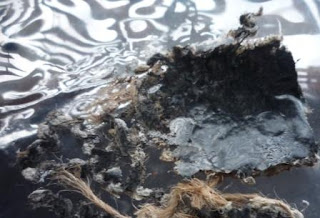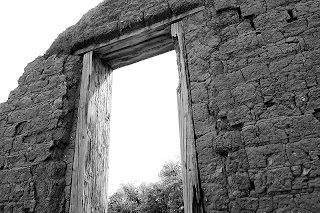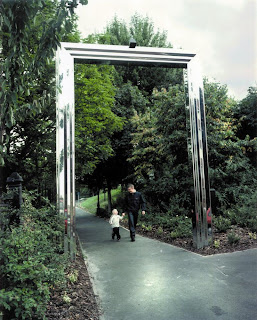My collection of submissions, critique feedback and 'junk' for Design II (Auckland University).
Friday, October 15, 2010
Thursday, October 14, 2010
Final tweaks to the concept

Sunday, October 3, 2010
Struggling with scripts & building again...
 Progress....have spent all morning trying to manipulate my door pull with a script to start when it's touched...once again things often don't work until you delete then restart or tweak and resave.
Progress....have spent all morning trying to manipulate my door pull with a script to start when it's touched...once again things often don't work until you delete then restart or tweak and resave.I've also finally figured out how to add a script to open the door without stuffing up the particle cloud script.
Living in the middle of nowhere with faulty cables under the road doesn't do much for our broadband speed so there is only a limited amount of work I can do on Second Life now.
Idea is that digital data about yourself is displayed as a 'cloud' when you touch the door pull - you're 'logging on' to the building...

I wish I'd found this last time - useful place for building questions: http://wiki.secondlife.com/wiki/Category:Building_Objects
Thursday, September 30, 2010
Digital vs Physical Clouds

- You inhabit the building, you wear the building when you enter, you attire yourself in it
- You leave traces of yourself on the door handle
Physical World = physical traces = skin cells, hair, sweat, finger prints, DNA. In the physical world, most of the dust in eg. your house is actually a cloud of your skin cells, your DNA, your physical trace...
Second Life = digital traces = tags such as your user name, your avatar image, your group permissions, your ownership details etc In Second Life, a cloud of digital data is associated with your presence there which contains your digital trace...
Digital clouds of tags (like a colony or ecosystem)
How to do this:
- create a particle cloud which is generated when an avatar touches the door handle and opens the door
- label the door (push, pull)
- textures for the particles will be snapshots of avatars, peices of code, text, usernames, permission groups
(p196-) Richard Coyne, The Tuning of Place. Sociable Spaces and Pervasive Digital Media. MIT Press: USA. 2010
Wednesday, September 29, 2010
Inhabit II - Data vs.DNA

Friday session points:
- Extension of previous ideas.
- Think of the building as a whole not just a small part of it.
- Occupancy - how does this change the place? how does a person's activity within the space change the space? In particular, what about all the people who are not in transit (ie. work in the offices?) how does a place change the people going through it?
- Leaving a trace (physical/digital)
- Inspiring creativity.... an idea is the result of a cummulation of different thoughts/a network, rather than a 'eureka' moment
Trace Evidence
Physical = fingerprints, DNA (cells, hair), fibres
Forensic photography = forensic imaging, crime scene photography = the art of producing an accurate reproduction of a crime scene or an accident scene. It is part of the process of evidence collecting.
Digital = anything left behind, the history, from digital media


- Physical versus digital ecosystems - free flow and exchange of energy versus data
- The traces we leave behind are like the ghosts of our previous selves...
Leaving behind a wisp of yourself, a cloud, mist as you walk through the door, wisp of smoke/fog/mist is a cloud made up of tiny digital traces of yourself. It eventually disperses but may slow down the person coming in behind you.????
Thursday, September 23, 2010
Wednesday, September 22, 2010
Final design concept - artificial cloud
NB. fog = cloud (just at different heights)
Rationale (1): this is a very sterile, hard, grey area. It has similarities with a deep ravine or cave in that it's a large vertical space on an almost 'geological' scale. However, in ravines and caves the light and air have different qualities - the air usually smells different: moist, ozone smell, plant smells; the light is often concentrated at the top. Creating a cloud with more light coming in from above brings some of this atmosphere inside and softens the space.Rationale (2): change something within the space triggered by people inhabiting the space. Disrupt normal behaviour.
Walking through a cloud (fog) disrupts movement, sound and light. When a large crowd of people is moving on the stairs they move as a large mass and people behave more or less in similar ways. However, if you encounter some thick fog you revert again to an individual; you feel more isolated/insulated.
Mass becomes individuals.
An artificial cloud is created within the atrium area, concentrated around the main steps going down when:
Implementation details:
- using RFID cards being carried (therefore anyone not carrying a card will not be detected or used as a trigger)
- sensors to detect these cards within a certain distance (to be detailed) will be installed in 4 places: at each side of the top of the main step area and also at each side of the bottom of the step area
- once the condition above is fulfilled, the cloud will be created in a similar way to common fog machines. However, to avoid potential irritants only pure water with no additives will be used (fog machines commonly use additives).http://vimeo.com/13648736
- adding water drops into a layer of air saturated with water vapor will result in a 'cloud'. In order to keep this cloud layer floating you need a dry cool layer with a higher density below
 and a dry hot layer with a lower density above. The high- and low-density layers prevent the cloud layer from moving up or down. However, movement will disperse the cloud, drawing it up/down depending on the movement and where it is.
and a dry hot layer with a lower density above. The high- and low-density layers prevent the cloud layer from moving up or down. However, movement will disperse the cloud, drawing it up/down depending on the movement and where it is. - the water for the cloud creation will be from recycled air conditioning system water and/or rain collection (currently rain water is collected and used in the toilets of the building)
Stratification is created by an air-to-air heat pump, extracting heat from the space below the cloud and supplying the heat into the space above the cloud, both by low flow air return systems without mixing the thermal layers. A second air handling unit with a humidifier and heater keeps the cloud in the requested temperature and humidity level. To operate the cloud only electricity and a bit of water will be demanded. Shutting off the systems will lead to a disappearance of the cloud in a time frame of around 15 minutes. To reduce the heat losses of the warm top layer into the roof space, a transparent foil could be installed around or in the background of the roof space.
Monday, September 20, 2010
Friday, September 17, 2010
Sounds & fog....
- the speed of sound is greater in denser materials, so the velocity of sound is greater in fog than in normal air.
- distant noises mostly sound low and dull; nearer noises are higher and brighter
- fog carries sound more efficiently than dry air, so even the faintest noises drift for miles. You can never judge distance accurately from the noises you hear in fog because they will probably be distorted in some way.
- size can become distorted too; when visibility in fog is between 30 and 150 yards (about 25 to 140 m), vessels and other objects frequently appear twice their normal size. This illusion effectively doubles the speed of approach...

Shadows are cast through fog in three dimensions.
The fog is dense enough to be illuminated by light that passes through gaps i
 n a structure, but thin enough to let a large quantity of that light pass through to illuminate points further on. As a result, object shadows appear as "beams" oriented in a direction parallel to the light source. These voluminous shadows are due to the same cause as crepuscular rays, which are the shadows of clouds, but in this case, they are the shadows of solid objects.
n a structure, but thin enough to let a large quantity of that light pass through to illuminate points further on. As a result, object shadows appear as "beams" oriented in a direction parallel to the light source. These voluminous shadows are due to the same cause as crepuscular rays, which are the shadows of clouds, but in this case, they are the shadows of solid objects.Tuesday, September 7, 2010
InHabit - intial thoughts
http://blog.cloudscap.es/
Inhabit the space above....clouds...somewhere to sit and linger....make people look up.
Being in fog makes you:
- feel like an individual (as opposed to a mass of people)
- feel anonymous
- hear things differently
- see things differently
- move more cautiously, slowly
Clouds/mist/fog information:
- Fog can be simply defined as a cloud touching the ground.
- Fog is denser so contains more water droplets than mist.
- Fog has a visibility of less than 1000m. This limit is for aviation purposes, but for the general public an upper limit of 200m is more realistic. Severe disruption to transport occurs when the visibility falls below 50m.
The atmosphere includes water vapour; a certain amount of water can be held as invisible water vapour at any given temperature. If air is cooled it holds less water and becomes super saturated. At saturation point, some of the water has to condense to form water droplets, which forms cloud.
Types of fog:
- Radiation fog = fog formed on clear, still nights when the ground loses heat by radiation, and cools. The ground in turn cools the nearby air to saturation point, thus forming fog.
- Advection fog = fog formed when very mild moist air moves over a cold ground especially in Spring when mild winds move across the country over icy ground. The lower layers of the air get cooled down rapidly to below the temperature at which fog forms.
- Hill/upslope fog = fog formed as mild moist air is forced to ascend a hill or mountain range. As the air moves up the windward side of the mountain it cools down, and again if the air becomes saturated then cloud is formed which, if below the top of the hills, gives fog.
- Coastal fog = fog which forms when moist air is cooled to saturation point by travelling over a cooler sea.
- Steam fog = fog seen rising from the ground after a rain shower. If the ground is warm, the water from the shower may evaporate. If the air above it is saturated and cannot hold any more water, the excess moisture condenses and looks like steam.
.
see: wikipedia entry on fog machines
Fog machines have been used as a security device for disorientating intruders...
Wednesday, September 1, 2010
InHabit - Owen Glenn building links
Herald article
http://www.aucklandplus.com/news-and-events/news/news-in-2008/business-school-shortlisted-for-world-architecture-award.cfm
World Architecture News
http://trendsideas.com/ViewArticle.aspx?article=10963®ion=1&topic=21
http://www.international-pc.com/aboutus/news/Surfaces/Surfaces%2010%20WEB.pdf
Thursday, August 26, 2010
Treshold Final Presentation & Critiques

(NB. the quality of the video clip above is not as good as the final presentation - in order to post on this blog I saved it in a smaller format)
Comments below are peer reivew critiques of my project.
Sunday, August 22, 2010
Threshold - plan for final products
- A3 sheets:
(1) plan of building with potential locations of cameras, projectors, sensors & screens;
(2) initial investigations and map of how I ended up with the final design - images of the resin experiments, graph, info on the glass to use and technology
(3) take screen shot of final movie image to blow up (or a series of images)
- Thing: animations of what the doors could look like ie. a series of video clips
To do: rotobrush image of me walking in, and out, overlay onto existing movies but with the addition of screens. Investigate effects on the door as it opens
Saturday, August 21, 2010
Threshold - video editing...
"Threshold" = transition zone, merge of 2 places, point of balance before entering one place or another
- the point at which my awareness of the 'outside world' (vastly different from student life) and 'design studio world' is in balance - just before one or the other takes over.
- represented by the doors between the courtyard and the foyer area containing the lift/doors to stairs/doors to student centre/door to studio - the glass separating in from out.
The reflections in the doors remind me of where I've come from and the action of opening the doors breaks this reflection - shatters it - and takes me to the place I'm going to.
I'll be experimenting with the idea of projections of a live video feed onto the glass doors using high tech surfaces (see Technology page):
1. Where I've Been - to represent moving away from this to something new
- (coming in): trees in the courtyard, the calmness outside, an image of me walking away from this, or,
- (going out): images of the studio, the busy activity, the concentration of people working, eating, talking, lots of movement, an image of me walking away from this
2. Where I'm Going - to encourage an awareness of where I'm about to be, and get me in the correct frame of mind for this
- (coming in): images of what's going on in the studio
- (going out): images of the outside, the weather, the trees etc
4. Adding in some still images from the initial investigations of 'merge' with carpet/resin
I'll create some video images of these ideas and see what works best in terms of representing the initial Threshold idea.
Friday, August 13, 2010
Threshold - reflections

Photo of the main doors into the area just outside the studio shows a reflection of what is behind - so is a merging of what you see before you, the 'transition' (door) and what is in front of you. This is the concept I want to explore further...
The black and white image shows the reflection (trees) a bit more effectively.
What makes a reflection seem more like reality? Probably the main thing = absence of your own figure moving within the reflection (if directly in front)
Could do this by having a video projection onto the surface, angle of camera would pick up image behind just above the height of average person.
Project by using a material for the surface which picks this up digitally, while remaining semi transparent. Is there a material like this?
Materials Experiments - TreshHold
.jpg) The focus of my threshold is the 'transition' between one space and another, where these 2 areas overlap and merge/mix and the boundary is blurred.
The focus of my threshold is the 'transition' between one space and another, where these 2 areas overlap and merge/mix and the boundary is blurred.I also intially wanted an emphasis on materials so did some 'experiments' with resin and other things that might resemble things that might appear in either space as part of the main environment eg:
- autumn leaves - shellac
- glass in the doors -resin/plastic sheet
- tiles - terracotta/orange crayon
- carpet
- lino
I melted or added the resin to a few things - nothing looked that great until I took some photos:.jpg)
.jpg)
.jpg)
.jpg)
Tuesday, August 10, 2010
Treshold - notes from talk with tutors
A venn diagram was drawn as the space I'm interested is the merging between the 2 places (Studio, Courtyard). A place where everything is on the same level, like the Carnival concept.
Task over the next 2 days is to investigate 'melding' of materials.... eg.
- some kind of transparent materials with stone
- resin with paint
- try melting some plastic in the microwave..
- melt using the stove top, iron, (with foil)
“Cartesian Wax” – a prototype for an environmentally responsive skin
Sunday, August 8, 2010
TreshHold - initial ideas
 Adaptive, reactive architecture - adapting to the environment
Adaptive, reactive architecture - adapting to the environmentsunlight, daylight, moonlight, temparature, rain, cloud cover
Rain: when it's raining, a cover would extent out further into the courtyard providing a place for people to stop and put up/put down umbrellas, put on/take off raincoats
- Sunny day: cover extends right back out of the way to let in more light to the transition area
- Low light: lighting automatically comes on and adjusts to the ammount of light coming in
- Temparature: colder, the threshold will adapt so that less outside air can easily flow into the transition area; hotter, the threshold area will allow more air to flow, creating a breez
Inviting people to enter
 light, temparature, sound, smell, movement
light, temparature, sound, smell, movement
A warm light coming from inside, pleasant temparature compared with outside, pleasant sounds and smells

















